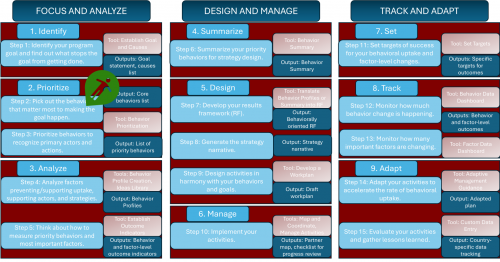The behaviors that matter most to your goal are those that are: (1) closest to your goal and (2) can impact on your goal. You want the behaviors that matter most to address the inhibiting causes you identified in Step 1: Identify your goal and find out what stops the goal from getting done.
Core behaviors are the initial list of behaviors you start with – no limits, no filters – just a brainstormed list of possibilities. This is your first crack at figuring out “who needs to do what” or what behaviors you are encouraging (priority behaviors) and among whom (primary actors).
From this list of core behaviors, you will narrow them down more and more as you complete Step 3: Prioritize behaviors to recognize primary actors and actions. In the end, you will land on a set of behaviors that are truly a priority for your program and that can make your goal happen.
Here are examples of good core behaviors for the goal of “Reduce infant mortality by 10% from [year] levels”:
- Mothers exclusively breastfeed for the first 6 months
- Expectant fathers support pregnant partner to deliver in a facility
- Local governments adequately fund postnatal care
- Traditional birth attendants refer women to health facilities for delivery
- Pregnant women sleep under an insecticide-treated net every night
- Pregnant women deliver in a health facility with an equipped, qualified provider
- Grandmothers-to-be encourage early initiation of breastfeeding
- Caregivers provide essential newborn care immediately after birth
- Caregivers seek prompt and appropriate care for signs and symptoms of newborn illness
- Service providers treat pregnant women with respect
- Logistics officers ensure a consistent supply of all essential commodities, including contraceptives
At this point in the process, it doesn’t matter if your behaviors are “perfect”. You’ll have many opportunities to improve the language of each of your final priority behaviors as you go along. But if you want to start off with expert examples, refer to our list of 25 high impact health behaviors.
Developing non-health behaviors? Not to worry. Just like any SBC (social and behavior change) or SBCC (social and behavior change communication) approach, BIG can be applied to health or non-health centered development goals!
A behavior is written from the point of view of one primary actor (the person practicing the behavior). It describes the primary actor you are working for and what you hope they can do because of your work. Think of it like this: the primary actor is the beneficiary you are working for, not necessarily working with.
Here is a general formula that can help you write a Behavior:
{ SPECIFIC PRIMARY ACTOR } + < ACTION VERB > + [ ISSUE TO BE ADDRESSED ] + ( GEOGRAPHY OR OTHER SPECIFICS, IF NEEDED )
Let’s look at some examples of well-written behaviors using this formula:
- { Property-owning citizens } < pay > [ full property rates ] ( annually ).
- { Energy consumers } < use > [ reliable and affordable electricity services ] ( in the Northern region ).
- { Teachers } < improve > [ the quality of instruction in the classroom ].
- { Vulnerable households } < use > [ social safety nets ] ( where social services outlets exist ).
Once you have your complete list of core behaviors in hand, move your core behaviors to priority behaviors.




 The Manoff Group was acquired by JSI in 2022.
The Manoff Group was acquired by JSI in 2022.